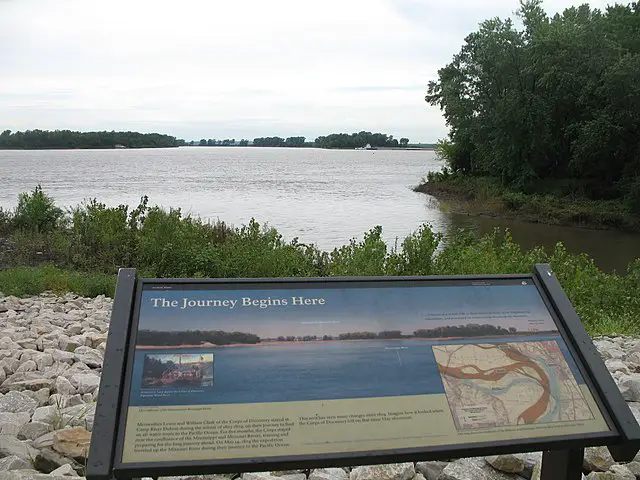The Beginning
President Jefferson gave Meriwether Lewis and William Clark the power to recruit people for their “Corps of Volunteers” to head out and explore the new lands added due to the Louisiana Purchase.
Clark began his recruitment process in an area that was north of St. Louis, Missouri, called Camp DuBois. He was looking for healthy men that were unmarried and had excellent survival and hunting skills.

Within a short amount of time, the Lewis and Clark expedition had 45 unmarried soldiers, a boat crew that had been contracted, a slave named York who was owned by Clark, and a French-Indian interpreter.
Lewis and Clark worked with President Jefferson to establish a specific set of goals that would be accomplished during the expedition. Their objectives were:
- To follow the Missouri River to its source and discover its tributaries
- To create maps of the new territory gained in the Louisiana Purchase
- To find a water route, ‘Northwest Passage’ to the Pacific Ocean
- To undertake scientific tasks, documenting descriptions of newly discovered animals and plants
- To learn about the climate, soil, and terrain of the new lands
- To learn about the customs and culture of the Native American Indians
Supplies were the main concern because once the expedition started, they knew that they wouldn’t have access to any civilized areas.

The team had to carry everything that they needed for food, shelter, and total survival. The list included:
- Food, Shelter, Tools and Camping Supplies
- Clothing Supplies
- Medical Supplies
- Weapons and Arms
- Scientific and Mathematical Instruments
- Maps, Reference Books and Writing Materials
- Gifts for Native American Indians
Some of the specifically required supplies that were needed also included:
- surveying instruments including compasses, telescopes, quadrants, sextants, and a chronometer
- camping supplies including oilcloth, tools, steel flints, utensils, mosquito netting, corn mill, fishing equipment, salt, and soap
- clothing
- books on botany, geography, and astronomy
- maps
The sheer volume of supplies that they took with them is understandable because the expedition was expected to last around two years or more.
They also knew that along the way, they were going to meet both friendly and unfriendly Native Indians, and they hoped that their interpreter would be able to let all know what they were doing and that they meant no harm.
Part of the tradition among most of the tribes included the exchange of gifts to show good faith. Some of the gifts for the Native Indians included:
- Beads
- Knives,
- Ivory combs
- Face paint
- Tobacco
- Ribbons
- Brightly colored cloth
- Mirrors
- Sewing items
It was established early on that both Lewis and Clark would need to keep a strong sense of discipline. Anyone that caused problems or disobeyed was dealt with harshly.
Some of the punishments included hard labor and even lashing on bare backs. The entire concept of survival depended upon all acting like a complete team, and they couldn’t afford anyone getting out of line.
The weather was a major concern, and each season would bring situations that could be potential disasters. Hard winters meant that they wouldn’t be able to travel and would have to build shelters, and hot, humid summers would bring out massive numbers of insects and mosquitoes.
Traveling along rivers with strong currents could mean that an accident might make them lose all of their equipment and supplies. While the expedition was well-funded, once they set out, they would be on their own and had to depend on all team members to keep everyone alive.
William Clark and his Corps joined Meriwether Lewis in St. Charles, Missouri, on May 14, 1804. They made their way up the Missouri River, battling strong currents and a barrage of swarming insects.
It was a slow hard trip, moving only fifteen miles per day. They faced their first disaster on August 20 when Sgt. Charles Floyd, a 22-year old member of the Corps, died of an infection in his abdomen. This would be the only Corps member that died on their entire journey.



